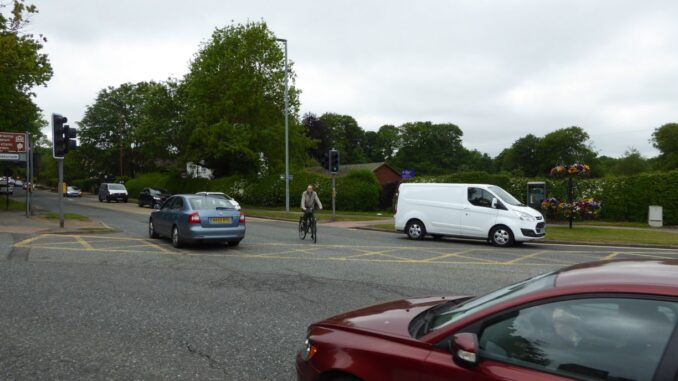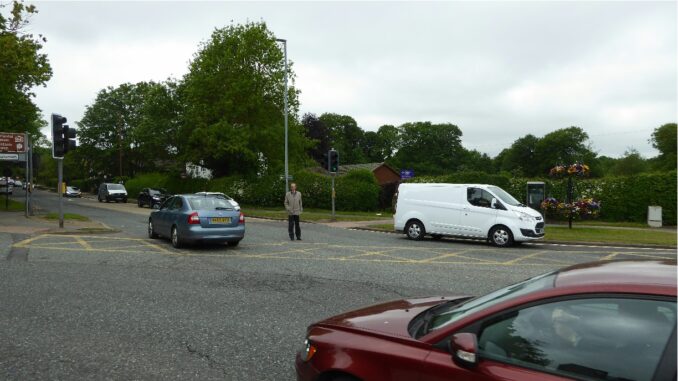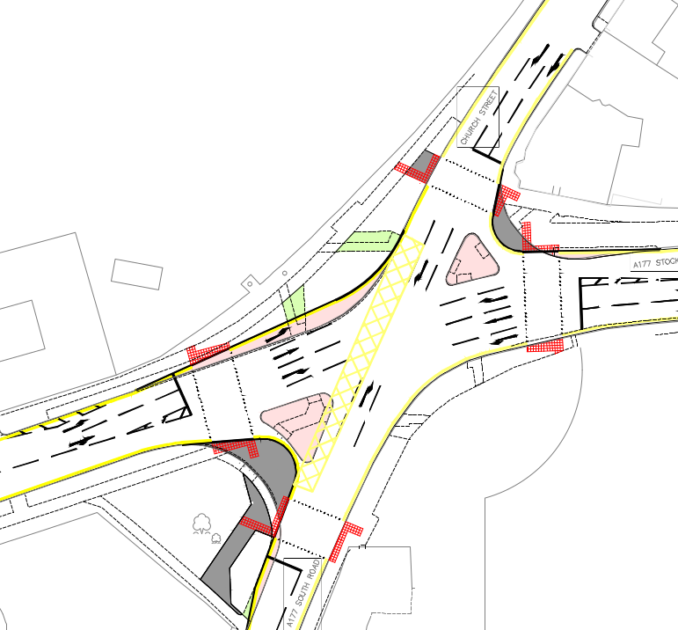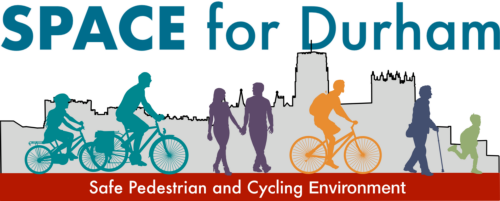
Over the years the authorities have put a lot of effort into promoting cycling, often via special events like Cycle to School Week, Green Transport Week or World Car Free Day, or encouraging participation by getting people to compete by logging their cycling, such as in the current Winter Wheelers campaign from Love to Ride UK. But what is it really like getting about on a bike for people who are new to cycling on our roads?
Look at the picture above. It is a busy junction in Durham, with no special provision for cycling. The cyclist in the picture is waiting to turn right. He will probably have to sit there waiting until the lights start to change, as the constant stream of vehicles coming towards him will not offer a gap to get across the road.
It looks normal, doesn’t it? We are expected to treat cyclists just like other vehicles, waiting their turn.
Here is another picture. This time there is a pedestrian standing in the road, with oncoming traffic going past on one side, and more vehicles coming up behind on the other side. This doesn’t look normal, does it? Think about being in that situation. You might expect one of the cars to slow, or come to a stop, to allow the pedestrian to reach safety.

The feelings evoked by the second picture are probably much closer to how most people experience cycling on our roads. Sitting on a bike gives very little extra protection if you are hit by a car or a van. It is just as unnerving waiting to make a right turn on a bike, with cars coming up behind you (on your left, you hope) and oncoming vehicles passing on the right, as it would be standing there as in the picture above.
The National Travel Attitudes Survey in 2020 found that 66% of adults (and 71% of women) agree that “it is too dangerous for me to cycle on the roads”. Many other surveys have found similar results. This is why the most important measure to enable people to cycle more is not promotional activities, but to provide safe infrastructure, such as separated cycle lanes, and separate phases at traffic lights.
Fortunately the County Council has recognised that the junction shown in these pictures is not satisfactory for cycling. In the Local Cycling and Walking Infrastructure Plan for Durham City the four roads meeting at the New Inn or Whitechurch junction have all been identified as primary cycling routes. On such routes, the plan says, there would be “cycling provision at all junctions along route, with priority given where possible”.
You may have seen roadworks at the junction recently. Sadly, this is not heralding improvements for cycling. Instead the Council is planning to remodel the junction early in 2023 to improve safety for pedestrians by abolishing the traffic islands and reducing the time between pedestrian phases. But in doing so, they are making the junction wider. The two lanes approaching the junction would split into three beyond the lights. The cyclist waiting to turn right will in future be facing two streams of vehicles oncoming on his right, and two streams of traffic coming up behind on his left.
Try promoting cycling in those circumstances!

The Council promises that further improvements will be made to cater for cycling, once funding is secured. They hint that this would involve toucan crossings (where cyclists and pedestrians share the same crossing, because ‘two can’ cross), but have not provided any drawings. The national guidance, Cycle Infrastructure Design (LTN 1/20) has this to say about toucan crossings at junctions:
10.6.19 Toucan facilities can be provided at signal junctions, either in a walk-with-traffic configuration, or as a full toucan stage. However, to accommodate this it is necessary to provide shared use facilities around the junction and therefore it is unlikely such an arrangement would be suitable where pedestrian and cyclist flows are high.
It is hard to find a location in Durham where pedestrian flows are higher! A shared use solution for this junction would therefore not comply with the guidance.
The document goes on to say that if such a scheme is being considered “it is essential that local accessibility groups are involved at an early stage”. SPACE for Durham has raised various concerns with the Council, but at the time of writing we have no confidence that the Council is taking account of our views.

Good article and those images really highlight the point you are making.
I could see that becoming a series, the juxtaposition of ‘normal people walking’ in the conditions that cyclists have to put up with.